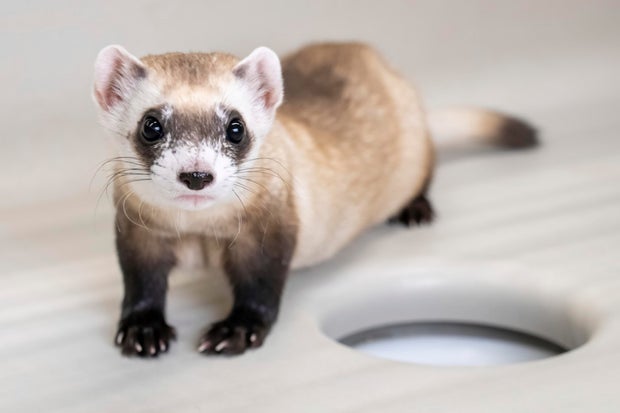Two more black-footed ferrets were cloned from the genes used for the first clone of an endangered species in the US, bringing to three the number of stealth predators genetically identical to one of the last animals found in the wild, the US Fish and Wildlife Service announced Wednesday.
Efforts to create the first clone, a female named Elizabeth Ann born in 2021, failed, but the recent births of two more cloned females, named Noreen and Antonia, in combination with a captive breeding program launched in the 1980s, are raising hopes of diversifying threatened species. Genetic diversity can improve a species’ ability to adapt and survive despite disease outbreaks and changing environmental conditions.
Kika Tuff/AP
“More diversity is better. So you’ll be more prepared for things like changes, weather and other things,” said Dr. Della Garelle, an FWS veterinarian who works with ferrets. told CBS “Sunday Mornings” in 2023.
Energetic and curious, black footed ferrets It is a nocturnal type of weasel with dark markings on its eyes that resemble a thief’s mask. Their prey is prairie dogs, and ferrets hunt the rodents in large burrow colonies on the plains.
Black-footed ferrets are now a conservation success story – after being virtually exterminated in the wild, thousands of them have been bred in captivity and reintroduced at dozens of locations in the western US, Canada and Mexico since the 1990s.
Because they fed exclusively on prairie dogs, they fell victim to the efforts of farmers and ranchers to poison and shoot the land-dwelling rodents—so much so that they were considered extinct until a farm dog named Shep brought a dead animal home to the West. . Wyoming in 1981. Conservationists were able to capture seven more and establish a breeding program.
But their gene pool is small – all black-footed ferrets known today are descendants of these seven animals – so diversifying the species is extremely important.
Noreen and Antonia, like Elizabeth Ann, are genetically identical to Willa, one of the original seven. Willa’s remains — frozen in the 1980s and kept at the San Diego Zoo Wildlife Alliance’s Frozen Zoo — could help conservation efforts because her genes contain about three times as many unique variations as are currently found among black-footed ferrets. , according to Fish. and Wildlife Service.
There are more than 10,000 specimens at the Frozen Zoo, everything from fur to feathers, CBS News said. Jonathan Vigliotti reported last year.
“When I was freezing northern white rhino cells, there were 50 alive. And now there are two left,” curator Marlys Houck told Vigliotti.
Barbara Durrant, Frozen Zoo’s director of reproductive sciences, said her cell bank could help save about a million species at risk of extinction, primarily because of humans.
And in some cases, a species’ depleted population can only be corrected by science. Durrant said, “If we disappeared, many things would grow back. But some populations are so small, or don’t even exist except here, that they wouldn’t be able to regenerate without us.”
Elizabeth Ann still lives in National Black-Footed Ferret Conservation Center in Fort Collins, Colorado, but she was unable to breed due to a reproductive organ problem that is not the result of cloning, the Fish and Wildlife Service said in a statement.
Biologists plan to try to breed Noreen and Antonia after they reach maturity later this year.
The ferrets were born at the ferret conservation center last May. The Fish and Wildlife Service waited nearly a year to announce the births amid ongoing scientific work, other black-footed ferret breeding efforts and other agency priorities, a Fish and Wildlife Service spokesperson said. , Joe Szuszwalak, via email.
“Science takes time and does not happen instantly,” Szuszwalak wrote.
Cloning produces a new plant or animal by copying the genes of an existing animal. To clone these three ferrets, the Fish and Wildlife Service worked with zoo and conservation organizations and ViaGen Pets & Equine, a Texas company that clones horses for $85,000 and pet dogs for $50,000.
The company also cloned a wild Przewalski’s horse, a species from Mongolia.






















